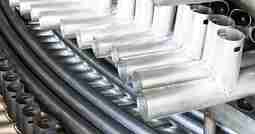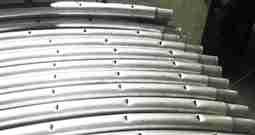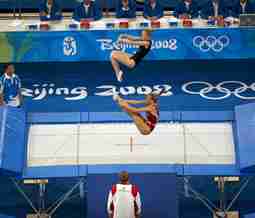
What Are Trampolines Made Of? (Frames, Springs, and Mat)
When it comes to trampolines, the first thing we ought to remember is that there are four main parts of them. Each trampoline consists of a mat, some springs, tubing and safety pads.
However, that doesn’t tell us a lot about how manufacturers make trampolines. What we need are more details! We need to know more about the materials used for making trampolines, as well as where companies make them and how.
Luckily, we have all the answers right here.
First Things First — What Was The First Trampoline Made Of?

Now, to answer this question, we first had to figure out who had invented the first ever trampoline. Fortunately, that wasn’t too difficult, as trampolines are quite popular nowadays. One simple Google search later, and we have our answer — the inventor was George Nissen, who worked with Larry Griswold, his gymnastics coach, to create the modern trampoline.
Mr. Nissen was a gymnast who loved watching trapeze artists do their magic. However, upon seeing their safety net, he wondered whether another contraption could be of more use.
Mr. Nissen was onto something glorious. Back home, he immediately started working on the design. Or, rather, he strapped a piece of canvas to a rectangular steel frame. And voila!
Later on, with the help from Mr. Griswold, he improved the design and made it a bit bouncier by using tire inner tubes.
But how are modern-day trampolines different? Let’s see.
What Material are Trampolines Made Of?

In order to answer this question, we need to be a bit smart about it. We cannot just say “Oh, companies usually use metal to make the trampolines.” Of course they do. But what is trampoline fabric made of? Is it a plain mat or something extra special?
What Metal are Trampolines Made Of?
More often than not, in order to ensure that the trampoline stays in top-notch condition over the next few years, manufacturers opt for steel. This alloy of iron and carbon gives the trampolines a solid construction. Moreover, knowing that their favorite piece of equipment is a steel piece of art gives a lot of people some peace of mind. A trampoline made of steel is robust, safe and, above all, able to endure lots of jumping.
What are Trampoline Frames Made Of?
The trampoline frames, or rather the tubing, is usually made of galvanized steel. Why? It’s simple, really. By using galvanized steel, manufacturers can ensure that the frames don’t get rusty too soon. Moreover, since most of us keep our trampolines outside (in our backyards, for example), they have to be resistant to all sorts of weather conditions. That’s where the galvanized steel helps — rain or shine, the trampoline should look great!
What are Trampoline Springs Made Of?
Now, contrary to popular belief, it’s not the mat that gives a trampoline its well-known bounce. The reason why trampolines are bouncy is the fact that they come equipped with a bunch of springs.
These springs are the most important pieces of the trampoline, as, without them, it has no real purpose. Therefore, just like the tubing, trampoline springs are made of galvanized steel.
However, it’s good to point out that the manufacturers are the ones who determine which springs and how many they want to use. Usually, they make the springs as well.
Still, know that some trampolines also come with elastic bands rather than springs. These are not as effective as springs, as they can quickly lose the bounce.
The Trampoline Mat Material
Finally, we have the trampoline mat, which is the part where all the fun and jumping happens. Most often, this part of the trampoline is made of polypropylene trampoline fabric.
The best part about this tightly webbed fabric is that it is the safest material anyone can use to make a trampoline. Once webbed, the manufacturer thermally interlocks it to make into a very smooth surface, perfect for jumping on for hours and hours.
But why is it the safest material, you may ask? Well, there are a couple of very good reasons:
- This fabric is naturally very strong and durable. Thus, it can stay in great condition even in the toughest environment, not to mention handle a couple of very eager children.
- Since it’s smooth, it won’t hurt our feet while we’re jumping on it.
- It’s quite flexible, which means we’ll get that perfect bounce every time.
- It also comes with UV protection.
- Since it’s mildew resistant, we can use trampolines that come with this sort of fabric both indoors and outdoors.
- The best part — it’s anti-slip, so it will stop us from injuring ourselves.
But That’s Not Everything we Need to Know About Trampolines
Apart from the basics such as the materials most trampolines consist of, there are some other questions everyone is eager to find out answers to.
Where are Trampolines Made?
Unfortunately, we don’t have a clear answer to this, purely because people make trampolines in almost all parts of the world. Manufacturers make them in their factories, and the best ones come from China, Australia, USA and Europe.
How are Trampolines Made?

Now, this is actually an interesting process, so we’re glad we can teach you more about it.
The first thing that a manufacturer needs to start making a trampoline is the tubing. So once the tubes arrive, they actually bend them into arcs and punch some holes into them.
After that part, the manufacturer has to weld the sockets so that the legs can fit into the frame. Once connected, the whole frame should create a circular design. Of course, unless the trampoline should be rectangular.
However, in terms of the fabric for the jumping mat, the manufacturers most often outsource them. So once the fabric arrives, they just have to cut it into the right shape and sew on the reinforced web strapping. Moreover, they also add the D-rings, which are absolutely necessary if we want the mat to stay put, i.e., hold onto the frame.
In order to increase the trampoline’s stability, they also sew straps and a vinyl cover around the foamy safety pads. And that’s it! Once done, they package and ship them away. Later on, the customers have to assemble them, but usually, that doesn’t take too long.
Are Trampolines Made of Latex?
Some trampolines surely do entail the use of latex, but they are not that great when it comes to stability and safety. Moreover, latex can cause an allergic reaction, so most manufacturers, especially those who make inflatable trampolines, usually stay far away from it.
Are Trampoline Frames Made of Aluminum?
Just like with latex, some trampoline manufacturers do use aluminum to make their trampolines. However, that doesn’t seem like a fine choice at all. Galvanized steel is much more durable and more stable than aluminum. What’s more, a trampoline frame made of steel is fantastic if we want to use the trampoline outside, as it will have a longer lifespan and won’t go rusty fast.
What are Springfree Trampolines Made Of?
Many people consider Springfree trampolines some of the safest trampolines on the market. Their design allows users to stay entirely safe by eliminating the need for springs and safety pads.
Springfree uses an advanced composite material to make both the nets and the mat rods. Thus, their trampolines can withstand many hours of jumping without causing any injuries.
However, they do have a steel frame, just like other trampolines, and UV protection on the mat that allows it to stay in excellent condition even outdoors.
Still, they use a geo-textile construction fabric to make the mats, which gives them a serious advantage over their competitors. Their trampolines can withstand up to 1100 pounds of static weight.
What are Olympic Trampolines Made Of?

Although similar in design, Olympic trampolines have to hold more than just a few kids and their parents. They are specially made for the Olympics so that the competitors can have the best chance possible for winning a medal.
Yet, there are a few requirements they must meet. In the competition, there are two rectangular trampolines. The rules say that they have to be 2 meters apart and that each one has to be 5.05 meters long. Moreover, they have to be 2.91 meters wide with a height of 1.155 meters.
Even the mat has to be perfect. Olympic trampolines come with a durable woven nylon mat that consists of many 6 mm thick bands. Moreover, each trampoline has almost 130 steel springs (118 to 126, to be exact).
Since it’s the Olympics, the trampolining is not that much of a leisure activity. It’s a sport there, so it has to abide by the rules. Thus, competitors have to stay in the jumping zone, which is 108 cm wide and 215 cm long.
Safety Comes First When Making Trampolines
And that’s it. We hope that you have all the answers you’ve been looking for. Although seemingly simple in design, it seems that trampolines are a lot more difficult to make than one may have thought. Moreover, safety is of the utmost importance, which just goes to show why some trampolines cost more than others.
If you’ve liked this article, then don’t be afraid to share your newly found knowledge of trampolines with your friends and family. What’s more, tell us in the comment section if you’ve learned a lot from our article and whether you think we need to add something. We’re waiting for your feedback!

